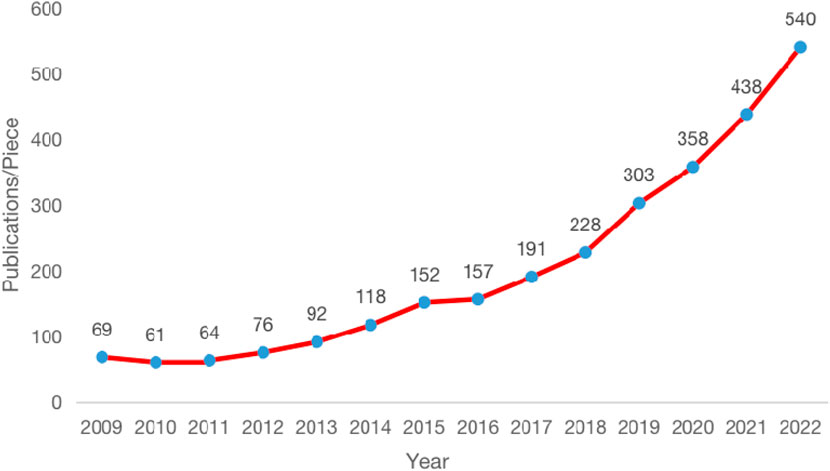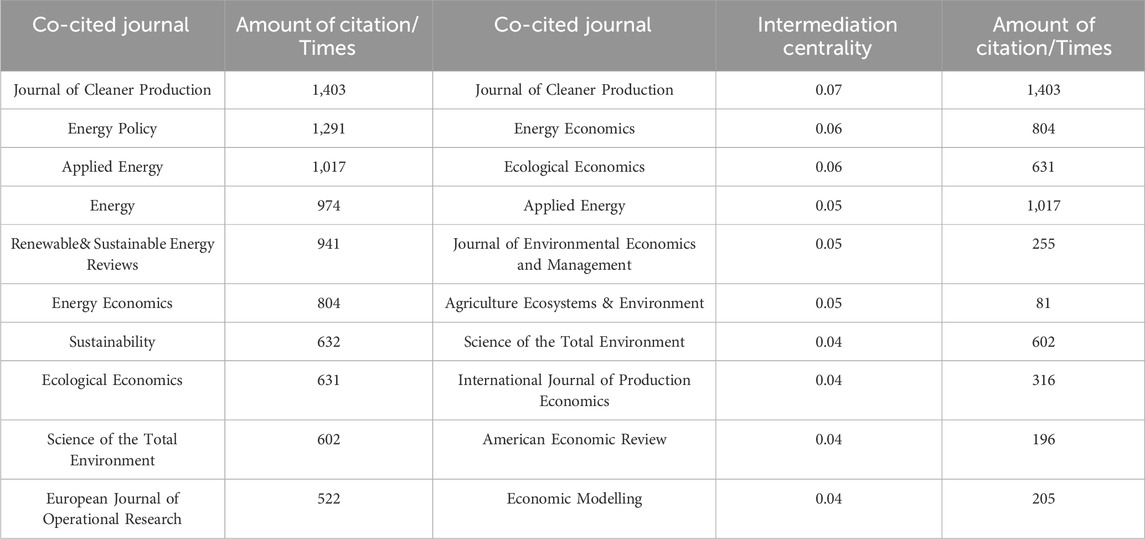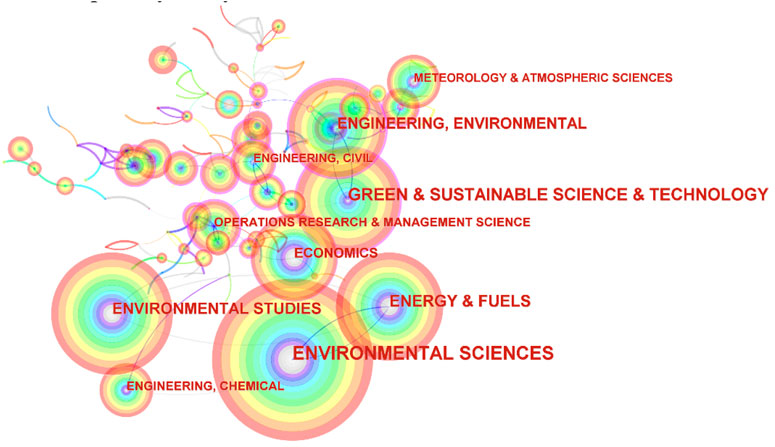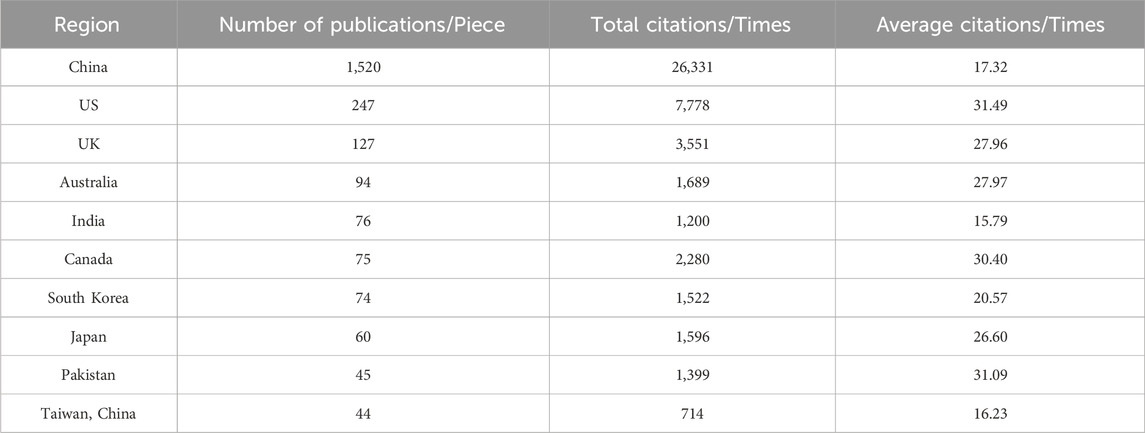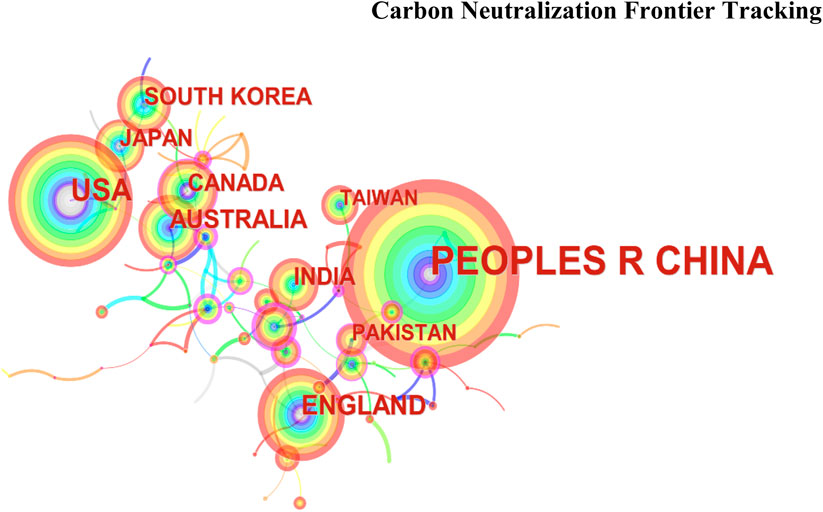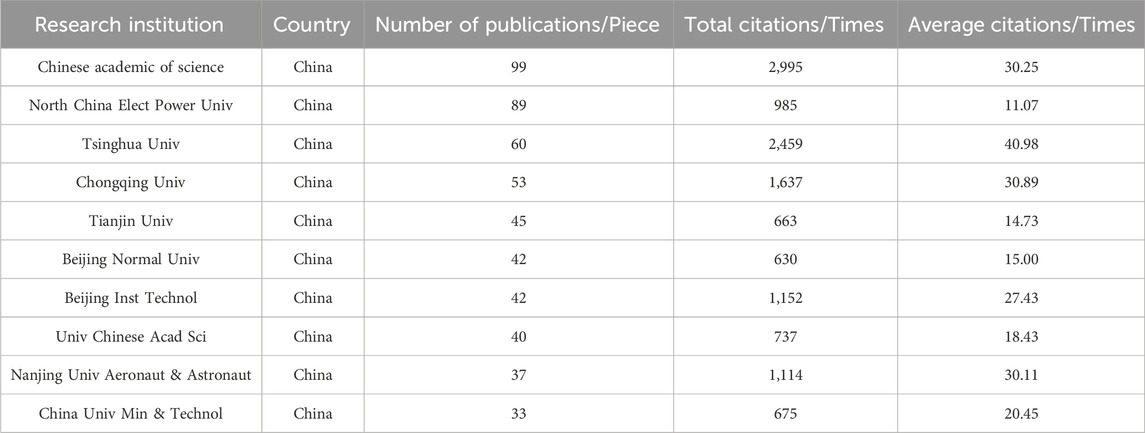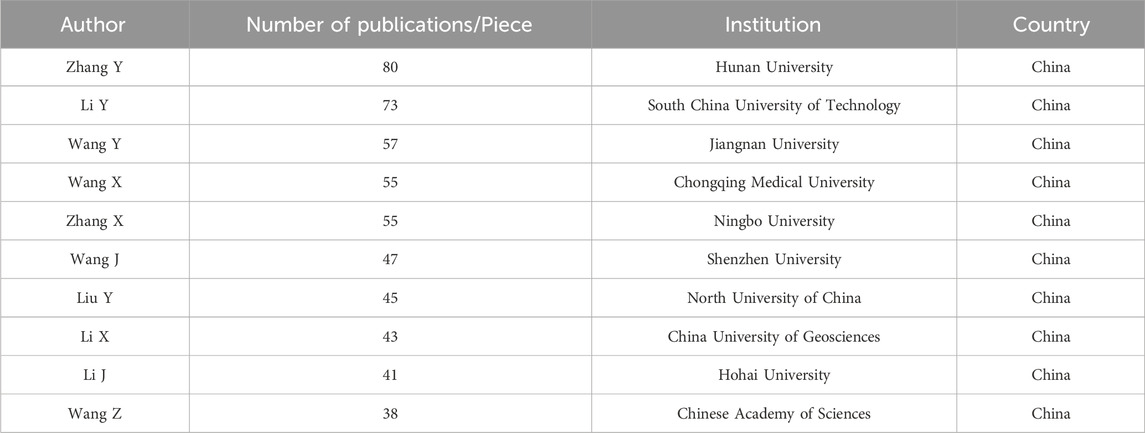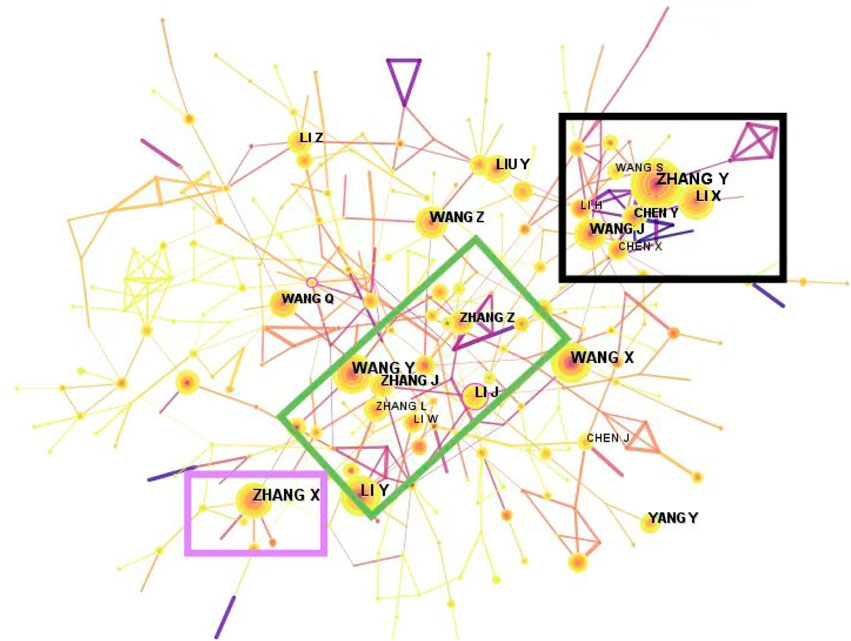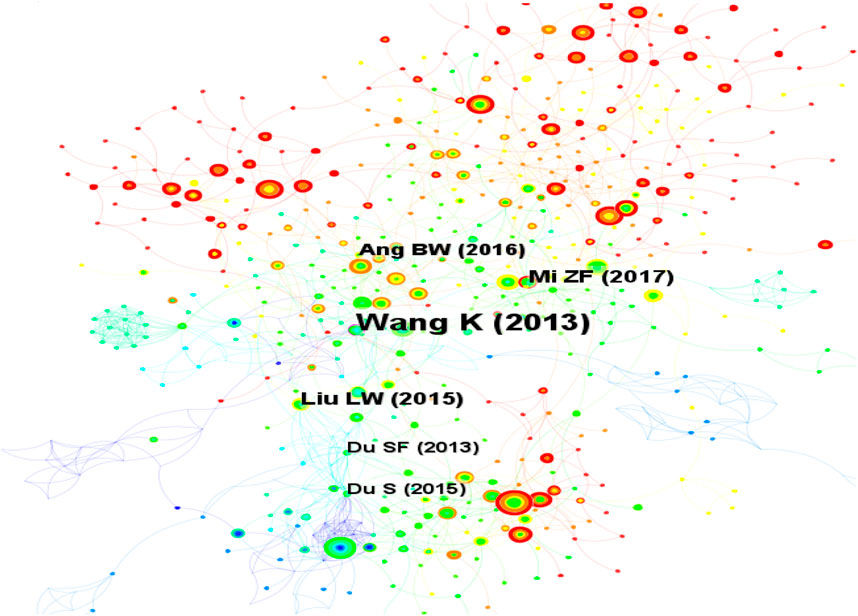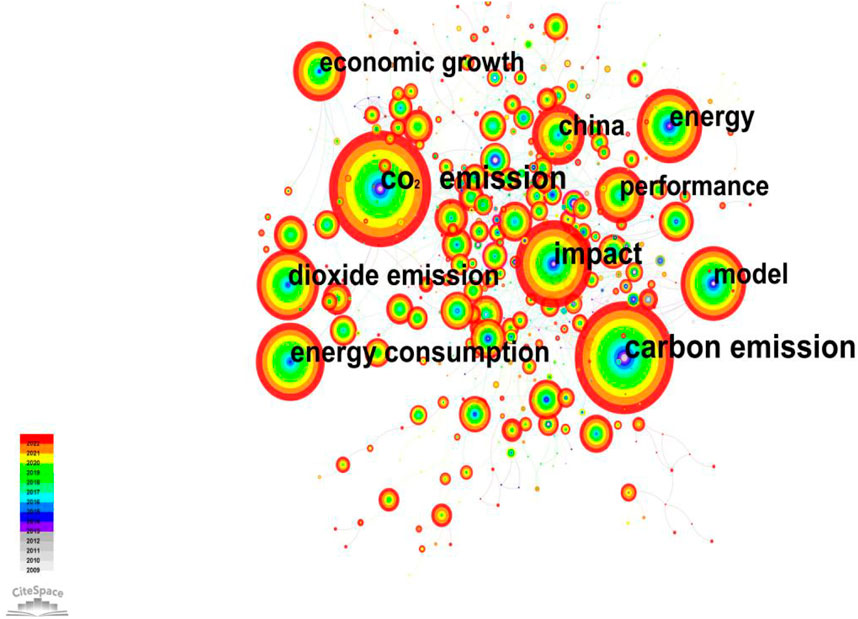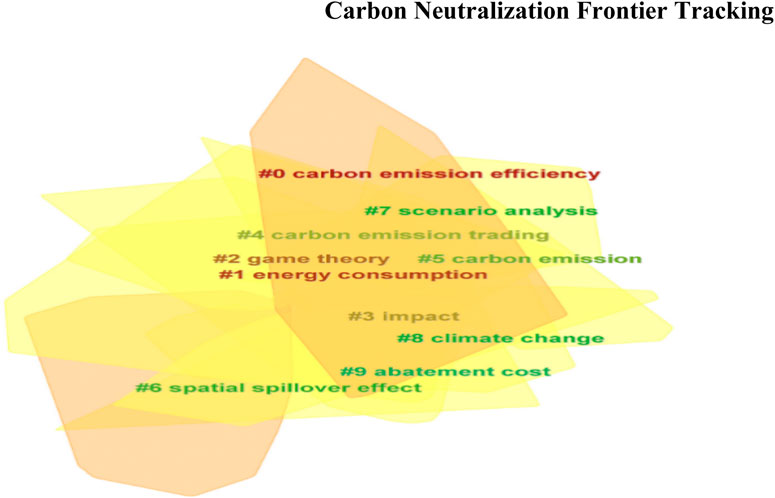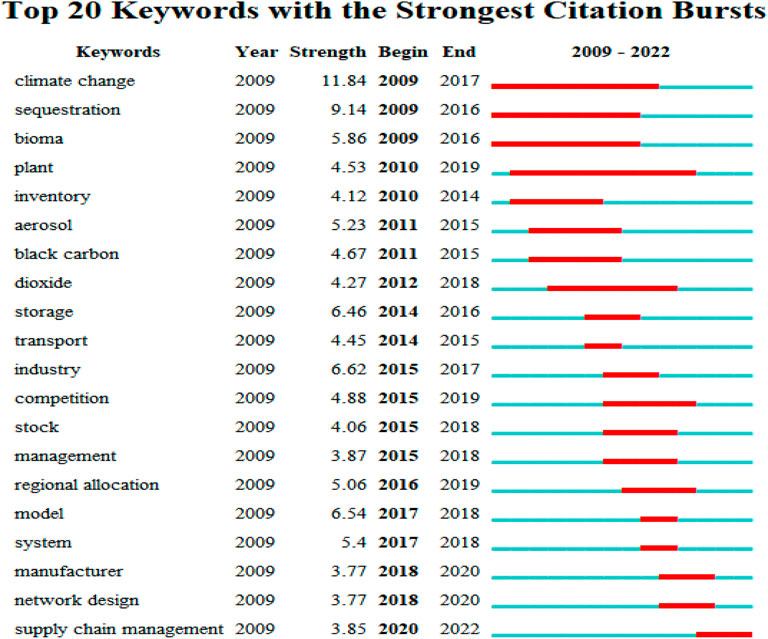- 1College of Economics and Management, Shenyang Agricultural University, Shenyang, China
- 2School of Banking and Finance, University of International Business and Economics, Beijing, China
- 3Research Institute of Forestry Policy and Information, Chinese Academy of Forestry, Beijing, China
- 4Chinese Academy of Inspection and Quarantine, Beijing, China
- 5Chifeng City Hongshan District Dongcheng sub-district office, Chifeng, China
This systematic study on the international research trends in carbon neutrality underscores its critical role in combating global warming and advancing sustainable development. By leveraging the “Web of Science Core Collection” databases and employing CiteSpace software for visual analysis, we examined 2223 research papers to track the influence and trends of key countries, institutions, and authors. Our results reveal a significant increase in publication volume, indicating a robust development potential for carbon neutrality research. The study also identifies environmental science, environmental research, and energy and fuel science as central interdisciplinary hubs, highlighting the importance of cross-disciplinary collaboration. Notably, China leads in publication output but has room for improvement in citation impact, suggesting a need for enhanced research quality and international visibility. The study's findings are instrumental for guiding future research directions, policy-making, and interdisciplinary cooperation, particularly in the fields of environmental science and energy, to accelerate progress towards carbon neutrality and global climate governance.
1 Introduction
As the third industrial revolution mainly relies on traditional fossil energy as the driving force for industrial development, the incineration of fossil energy produces a large amount of carbon dioxide, and the increase in these greenhouse gas emissions leads to the aggravation of global warming (Shi et al., 2022a; Tan et al., 2023; Hou et al., 2022). The harm caused by climate warming may affect everyone in the world (Shi et al., 2022b; Diffenbaugh and Barnes, 2023; Huang and Huang, 2022; Chai et al., 2023; Cheng and Xiao, 2023). The reason is very simple. For example, due to the greenhouse gas emissions on land, the temperature difference between the continent and the ocean will become smaller and smaller, which will slow down the air flow speed, and the haze cannot be blown away in a short time. The haze will become more and more intense, which will seriously threaten human production and life.
Governments around the world have gradually come to realize the harm caused by global warming. They have put forward their own goals of “carbon peaking” and “carbon neutrality”, reached consensus on strategies to promote a global response to climate change, and carried out relevant actions. For example, in December 2019, the European Commission issued “the European Green New Deal” strategy document. It is proposed that the EU should achieve net zero emissions of greenhouse gases and realize decoupling of economic growth and resource consumption by 2050 (Dong et al., 2021). In September 2020, based on the actual domestic situation, China proposed to achieve the peak of carbon dioxide emissions before 2030 and carbon neutrality before 2060 (Chao, 2022). In December 2020, Japan released the “Carbon Neutral Green Growth Strategy by 2050″document and will invest 2 trillion yen in the fiscal budget to promote eco-friendly business models and innovative development in order to implement the carbon neutral goal by 2050 (Liu and Tang, 2022). In November 2021, the United States released the “Long-term Strategy Towards Net Zero Emissions by 2050”, which outlined its commitment over the next 30 years to implement policies such as clean electricity investment, transportation and building electrification, industrial transformation, and reduction of methane and other non-carbon dioxide greenhouse gas emissions to achieve the goal of being carbon neutral by 2050 (Hou et al., 2022). According to the first “Global Development Report” released by the China International Development Knowledge Center, as of May 2022, 127 countries in the world have proposed or are planning to set carbon neutral targets, covering 88 percent of the world’s carbon dioxide emissions, 90 percent of its GDP, and 85 percent of its population. Carbon neutral policies are applicable not only at the national level, but also at the level of different entities such as enterprises, groups, or individuals. The 2022 Winter Olympics in Beijing, China, became the first to be “carbon neutral” by offsetting emissions from energy, transportation, and other sectors through forestry carbon sequestration, cooperative corporate sponsorship, and carbon inclusion. Bangladesh, being a country highly vulnerable to climate change, is acutely aware of the severe challenges posed by global warming (Ahmed et al., 2018). In response to these challenges, the government of Bangladesh has set “carbon peak” and “carbon neutrality” targets at the national level and has submitted corresponding Nationally Determined Contributions (NDCs) in accordance with the Paris Agreement, aiming to reduce greenhouse gas emissions and enhance the country’s climate adaptation capabilities (Rahman et al., 2017). In the energy sector, the government is actively promoting renewable energy policies to reduce dependence on fossil fuels and improve energy security (Kabir and Rahman, 2019). This includes implementing fuel substitution strategies in the transportation sector to promote the use of clean energy. Furthermore, Bangladesh is advancing green transportation initiatives that encourage the use of electric vehicles and other clean transportation modes, thereby further reducing carbon emissions from the transportation sector (Sultana and Forbes, 2018). To reduce overall energy consumption and emissions, Bangladesh has also implemented a series of energy efficiency improvement projects in the industrial, construction, and transportation sectors. In terms of international cooperation, Bangladesh has shown an active engagement, collaborating with developed and other developing countries to obtain necessary financial, technological, and capacity-building support to jointly advance the global response to climate change (Ahmed, 2017).
The goal of achieving carbon peak and carbon neutrality is to find ways to reduce or even avoid emissions of greenhouse gases, such as carbon dioxide, generated in economic activities and achieve high-quality economic development (Deng et al., 2021). Scholars have carried out a large number of studies on the characteristics of carbon emissions, influencing factors of carbon reduction, and carbon neutrality. For example, Wang M et al. believe that different cities have significant differences in economic development, population size, geographical characteristics, energy endowment, and the total and structure of carbon dioxide emissions from transportation (Wang et al., 2022); Kaya Yoichi finds that demographic factors are the root cause of the growth in carbon emissions; Grossman and Krueger put forward the environmental Kuznets curve and found that the impact of per capita GDP on carbon emissions increases first and then decreases (Kaya, 1990). Cross-border capital flows play a pivotal role in achieving carbon peak and carbon neutrality both locally and globally (Ma, 2023). Raza and Li (2023) conducted an in-depth analysis of the carbon dioxide emissions resulting from Pakistan’s energy consumption, identifying the primary sources of carbon emissions and performing a decomposition analysis of carbon damage to assess the specific environmental impacts of different energy uses. In another study, the potential for fuel substitution and technological innovation in Pakistan was explored to evaluate the effectiveness of these measures in reducing greenhouse gas emissions and promoting environmental sustainability (Raza and Tang, 2022). Baohong and Raza (2023) scrutinized the political discourse surrounding China’s renewable energy policies in the pursuit of carbon peak and carbon neutrality goals, examining the political dynamics and socio-economic factors behind policy formulation. Jiang et al. (2022) provided an in-depth analysis of the structure and development trends of Pakistan’s industrial economy and how these factors influence the country’s ability to achieve carbon emission reduction and sustainable development goals. The study further delineates that prospective inquiries into the impact of carbon dioxide emissions within energy-intensive sectors may encounter limitations such as constraints in data acquisition, the exigency for a profound analysis of the influence of technological efficiency and the integration of clean energy, considerations of regional disparities, the intricacies of policy implementation, and the integration of renewable energy sources.
Research on carbon neutrality is not only a reference basis for regional and even national policies but also an important guideline for tackling global climate change (Han, 2021). However, previous research results could not clearly show the internal relationship between a large number of carbon neutralization studies, and could not understand the overall picture of carbon neutralization studies from a broader perspective. CiteSpace software, as an important tool for quantitative literature analysis, presents a large amount of literature data information in a visual way, and generates atlas forms such as author co-occurrence, literature keyword co-occurrence, and keyword clustering, which can effectively describe the overall trend of the development of a discipline or research field (Ming and Chen, 2022; Zhu et al., 2023). It has been widely used to measure the performance of various disciplines or fields of study by showing the development history and internal correlation of those disciplines or fields of study. The present study, grounded in the Web of Science database and employing the CiteSpace software, has conducted an in-depth analysis of the current state of international carbon neutrality research. The research encompasses a range of dimensions including the basic characteristics of the literature, the integration of interdisciplinary fields, participating countries, research institutions, principal authors, and co-cited documents. Furthermore, this study has also tracked the frontiers of research in this field, aiming to provide significant references and insights for the future development of carbon neutrality research.
2 Materials and methods
2.1 Materials
The “Web of Science Core Collection” is used as the literature search platform for this paper. Meanwhile, the Science Citation Index Expanded (SCI-E) and Social Science Citation Index (SSCI) were selected as the databases, and the retrieval time span was set from 2009 to 2022. Given the concentration and accuracy of the literature, the retrieval strategy was set as TI = (“carbon neutralization” or “carbon neutral” or “carbon offset” or “carbon-neutral” or “peak carbon dioxide emissions” or “carbon emission”), DT = (Article), and LA = (English).
The title in literature retrieval is the title of the retrieval article, and the theme is to retrieve the article by searching the main idea of each article. In order to simplify the retrieval process, most of the literature is retrieved by the topic or keyword method. If the full name of the literature is known, the literature could be retrieved quickly and accurately by the title, which can avoid retrieving a large number of miscellaneous and useless articles. In the field of research publication, there is a greater inclination towards specifying publications in environmental science, engineering, energy economics, and related disciplines. The sample size was finally determined to be 2,223 articles. The retrieved file records were downloaded and saved as plain text files in the format “Full Record and Cited References”, which was used as the sample for data analysis in this paper.
2.2 Methods
CiteSpace software is one of the most influential analysis tools in the field of bibliometric analysis at present (Qiu et al., 2014; Qiu, 2018), which is a Java application for literature analysis visualization developed by Chen Chaomei, a Chinese scholar from Drexel University in the United States (Lei, 2017). This article uses version 6.1. R2.
Collaborative network analysis, co-occurrence network analysis, and other statistical analysis functions of CiteSpace software can help scholars objectively understand the status of the emergence of the target research field in terms of time, research institutions and members, keywords, highly cited references, etc. (Ji et al., 2019; Han et al., 2021). In order to meet the requirements of using these functions, the software parameters are set as follows:
1) Time Slicing is 2009–2022, Years Per Slice = 1.
2) Node types: research author, institution, country, keyword, category, reference, cited author, and cited journal.
3) Selection criteria are set to the default value.
4) Pruning Settings: most selected “Pathfinder” and “Pruning Networks,”, and “Pruning the Merged Network” was co-selected in author collaborative networks and keyword co-occurrence analysis. Other settings remain at default.
3 Results
3.1 Basic characteristics of literature
3.1.1 Number of publications
The variation in the volume of published literature serves as a pivotal metric for gauging the research activity within a particular domain (Schjønning et al., 1999; Xiao et al., 2017). This study utilized the “Web of Science Core Collection” as the platform for literature retrieval, encompassing a time span from 2009 to 2022 (with statistical data up to 20 January 2023, which does not represent the full-year data; hence, one published document from 2023 was excluded from the analysis). The findings revealed a continuous increase in the volume of publications in the field of international carbon neutrality (Figure 1), indicating widespread scholarly interest and robust potential for development in this area.
As can be seen from Figure 1, there were three breakthroughs in the number of articles in the field of carbon neutrality from 2009 to 2022. The first was in 2014, when the number of articles published exceeded 100 for the first time. The number of published papers grew very slowly before, but began to steadily increase after 2009, and the research results gradually increased. The second was in 2019, when the number of published articles exceeded 300 for the first time, and increased rapidly thereafter. The third was in 2022, when the number of published articles exceeded 500 for the first time, and the number is expected to continue to increase.
3.1.2 Main journal sources
By analyzing the top 10 journals in the international carbon neutral research field in terms of co-citation frequency and intermediate centrality (Table 1), it can be found that these journals share the common characteristics of a wide range of research fields and a high concentration of articles.
As can be seen from Table 1, the top 3 journals in total cited frequency are the Journal of Cleaner Production, Energy Policy, and Applied Energy, which lead the international research frontier of carbon neutrality. The top 3 journals with high mediating centrality are the Journal of Cleaner Production, Energy Economics, and Ecological Economics, and the highest mediating centrality is 0.07. These are the three journals in which research in the field of carbon neutrality is generally published. At the same time, it shows that the journals with a high number of publications and citations are not exactly corresponding.
3.2 Interdisciplinary analysis
As can be seen from Figure 2, the disciplines involved in carbon neutral research mainly include environmental science, environmental research, energy and fuel science, green and sustainable technology, economics, operations research and management science, engineering, civil science, chemistry, meteorology, and atmospheric science, with strong intersections. Among them, environmental science, energy and fuel science, and green and sustainable science and technology published the most. From the perspective of the criterion of centrality, the centrality of environmental science is the highest at 0.36, and that of energy and fuel science is 0.33, indicating that these two disciplines are the most active in the field of carbon neutral research and have close connections with other disciplines, so they are the hub nodes of multiple disciplines.
3.3 Analysis of main research region, research institution and author
3.3.1 Main research region
The number of publications, total citations, and average citations of the top 10 regions in the international carbon neutral field are shown in Table 2.
As can be seen from Table 2, in terms of the number of articles published, only the top three regions have more than 100 articles published. China topped the list with 1,520 articles. The US, with 247 articles, was second only to China. In terms of total citations, the top three regions are China, the United States, and the United Kingdom. In terms of average citations, among the top 10 regions, the United States had the highest average citations, reaching 31.49, followed by Pakistan (31.09) and Canada (30.40). It can also be seen that China ranked third from the bottom in terms of average citations (17.32), although the number of published articles was the largest among the 10 regions.
The color of the outer circle of the node formed in Figure 3 represents the number of published documents by December 2022. It can be seen from Figure 3 that the research results are consistent with those in Table 2, namely, that the carbon neutral research is mainly conducted in 10 regions: China, the United States, the United Kingdom, Australia, India, Canada, South Korea, Japan, Pakistan, and Taiwan. Five of the top 10 are from Asia: China, India, Japan, South Korea, and Taiwan.
3.3.2 Main research institution
The number of publications, total citations, and average citations of the top 10 international research institutions in the field of carbon neutrality are shown in Table 3.
As can be seen from Table 3, the average number of papers published by the top 10 research institutions in the world is 54, but there are only 3 research institutions with more than the average number of papers published, and they are all in China, namely, the Chinese Academy of Sciences, North China Electric Power University, and Tsinghua University. In terms of the number of publications, the Chinese Academy of Sciences topped the list with 99. In terms of total citations, the Chinese Academy of Sciences, Tsinghua University, and Chongqing University ranked in the top 3. In terms of average citation amount, among the top 10 scientific research institutions, Tsinghua University of China has the highest average citation amount of 40.98 times, followed by Chongqing University of China with 47.94 times, and the Chinese Academy of Sciences with 30.25 times.
It can be seen that no matter the number of articles published, the total number of citations, or the average number of citations, China’s scientific research institutions are among the top in the world and very influential in the field of carbon neutrality research. At the same time, it should be emphasized that although the number of articles published by the School of Aeronautics and Astronautics of Nanjing University is only 37, the total number of citations and the average number of citations are both very high, whose influence cannot be underestimated.
The collaborative network map is also used to further explore the number of publications of various scientific research institutions in the field of carbon neutrality, as shown in Figure 4.
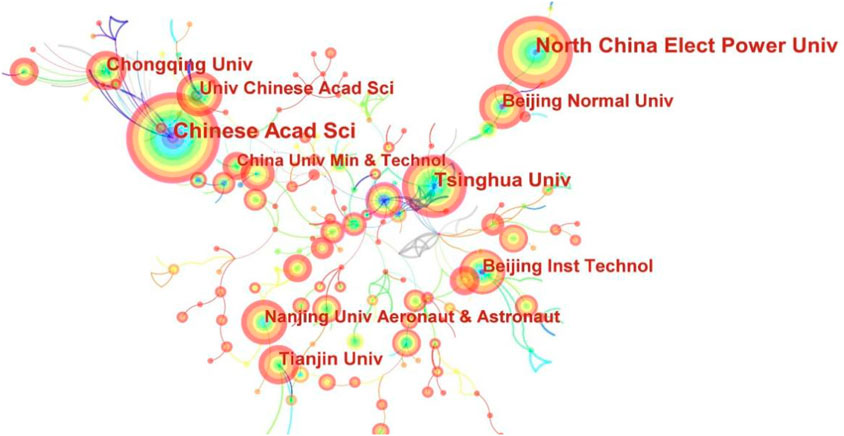
Figure 4. Collaboration network of carbon neutral research publications of various scientific research institutions.
It can be seen in Figure 4 that universities are the major carbon-neutral research institutions, accounting for a relatively high proportion. Nine of the top 10 scientific research institutions are universities: North China Electric Power University, Tsinghua University, Chongqing University, Tianjin University, Beijing Normal University, Beijing Institute of Technology, University of Chinese Academy of Sciences, School of Aeronautics and Astronautics of Nanjing University, and the University of Science and Technology of China.
3.3.3 Main author
The main characteristics of the top 10 international authors and their research teams in the field of carbon neutrality are shown in Table 4 and Figure 5.
As illustrated in Table 4, the top 10 authors in the field of carbon neutrality are all from China. Two authors, ZHANG Y and LI Y, both had more than 70 articles at most, occupying the dominant position. In terms of international carbon neutral research teams, three research teams with outstanding research achievements and significant team collaboration effects have been initially formed. The following figure shows the collaboration network of authors in the field of international carbon neutrality research (Figure 5). Each node in the figure represents an author; the larger the node is, the more the author has published in the field of carbon neutrality research; the thicker the line between the nodes, the closer the cooperation.
The author collaboration network in Figure 5 is composed of 524 authors and 859 collaboration links, indicating that there are a large number of researchers in the field of international carbon neutrality research and a wide range of collaborative relationships among them. The collaborators and research areas of the three main research teams are as follows:
1) The research team with ZHANG Y as the core (in the black box) published the most papers, up to 80. ZHANG Y cooperates with Chen, Xi, and other authors the most frequently and has the closest connection. According to the color of the connection between nodes, it can be seen that the cooperation between the three mainly occurs in 2019, 2020, and 2021. Zhang Y’s research team is mainly engaged in crude oil price forecasting (Zhang and Li, 2020), carbon trading policy (Zhang and Liu, 2021; Liu and Zhang, 2021), energy investment (Zhang et al., 2021a; Zhang et al., 2021b; Zhang and Pan, 2021), and carbon emissions (Zhang et al., 2020). The peak of the number of publications by Zhang Y’s team in the field of carbon neutrality was 15 in 2019. It can also be seen in the author collaboration network map that the color of the outer ring of the nodes formed is orange, indicating that the ZHANG Y research team has been active in recent years, which is consistent with the number of published papers from 2019 to 2021. It also indicates that Zhang Y’s research team will continue to explore the field of carbon neutrality in the future.
2) The research team led by Wang Y (in the green box) published a large number of articles, up to 57. Members of WANG Y’s research team are mainly engaged in the research of industrial pollution, industrial carbon emissions, and energy consumption tax in China (Wu et al., 2020; Wang and Wang, 2021; Liu et al., 2019; Gao and Wang, 2019). The peak of Wang’s team’s publication in the field of carbon neutrality was in 2022. It can also be seen in the author collaboration network diagram that the outer ring of the nodes formed is orange, indicating that WANG Y’s research team has published actively in recent years, which is consistent with the fact that the number of papers issued in 2020–2022 is 10, 12, and 17, respectively. This also indicates that Wang Y’s research team will continue to explore the field of carbon neutrality in the future.
3) The research team with ZHANG X as the core (in the purple box) published 55 papers, all of which were concentrated from 2016 to 2022. Members of ZHANG X’s research team are mainly engaged in the study of carbon emissions in the construction industry (Zhang and Zhang, 2021).
3.4 Analysis of literature co-citation
Literature co-citation analysis means that two or more documents are cited by one or more other documents at the same time, which is a research method to measure the degree of relationship between documents (Wang et al., 2013; Liu et al., 2015; Mi et al., 2017; Ang and Su, 2016; Du et al., 2015). The number of citations can reflect the research hotspot and trend to a certain extent, and the number of citations could also reflect the importance of articles. Hence, the co-citation of the research literature is very helpful for the dynamic exploration of carbon neutralization research. According to the centrality of the cited papers, the top six are listed in Table 5 and Figure 6.
It can be seen from Table 5 that, according to the centrality of the cited documents, the countries of the top three authors are all China. Among them, the strongest centrality is 0.12, which comes from the “Regional allocation of CO2 emissions allowance over resources in China by 2020,” written by Chinese scholar WANG K in 2013. This study mainly explores the allocation of efficient emission quotas, energy intensity, and non-fossil energy utilization in China.
As can be seen from Figure 6, in the centrality ranking of literature co-citations, Liu LW, who published China’s carbon-emissions trading in 2015, is second only to Wang K. The paper published by Liu mainly reviews the policy evolution and development of China’s carbon trading market, the factors that the Chinese government promotes the launch of the carbon market, traces the development of mandatory carbon emissions trading and voluntary carbon emissions trading, analyzes the shortcomings of China’s carbon trading market development, and puts forward specific measures to promote the development of the carbon trading market. The centrality of the other four literature is also strong (0.09, 0.09, 0.08, and 0.08, respectively). It can be seen from the literature titles that “carbon emission” has been a topic of constant concern for scholars for at least 10 years.
3.5 Analysis of research hotspots
3.5.1 Keyword co-occurrence
Keywords will reflect the author’s research direction and interests (Sun, 2012; Li et al., 2015), which is a high condensation and manifestation of the main research content of the paper. With the help of this, others can quickly browse the keywords of the paper to obtain effective information such as research objectives, research content, research methods, and views held by the author (Yin, 2009; Feng, 2010). Therefore, the analysis of the occurrence frequency of keywords in literature is the key to exploring the hot spots and changes in development in a certain research field (Pan and Wang, 2011; Yang, 2015).
This paper uses the keyword co-occurrence analysis function of CiteSpace software to draw the keyword co-occurrence network diagram of carbon neutrality research and measure the main research hotspots in this field (Figure 7). In order to more accurately reflect the main keywords in the field of carbon neutrality research, by setting the functional threshold for software co-occurrence analysis, Figure 7 only shows the keywords whose occurrence frequency is greater than or equal to 178 times. Each node in the figure represents a keyword, and the larger node indicates a higher frequency of keyword occurrence. Similarly, the width of the line represents the frequency of keyword co-occurrence, and the thicker line represents the higher frequency of occurrence between two keywords.
According to Figure 7, the keywords with frequency greater than or equal to 178 times, that is, the top 10, are CO2 emission (532 times), carbon emission (478 times), impact (328 times), energy consumption (262 times), dioxide emission (227 times), energy (225 times), model (209 times), China (205 times), economic growth (186 times), and performance (178 times). These keywords become important nodes in the network because of their high frequency.
These important nodes basically cover several major aspects of international carbon neutrality research: First, scholars mainly focus on “carbon dioxide emissions”, “carbon emissions”, and the “impact” of emissions as the starting point for carbon neutrality research; second, the main research directions are “energy consumption”, “low carbon consumption”, “energy,” and “economic growth”; third, the emergence of the keyword “performance” shows that scholars pay more attention to the performance of carbon neutrality.
In order to explore the close relationship between keywords, a cluster analysis of keywords in the research field of carbon neutrality is now carried out, as shown in Figure 8.
As can be seen from Figure 8, the keywords in the field of carbon neutrality are clustered into 10 categories, numbered 0 through 9. The smaller the number, the more keywords contained in the clustering. The 10 categories are carbon emission efficiency, energy consumption, game theory, impact, carbon emission trading, carbon emission and spatial spillover effects, scenario analysis, climate change, and abatement cost. Each cluster is composed of several closely related keywords. The specific keywords can be obtained by exporting the detailed information about clustering from the report (Table 6). In this network, attention should be paid to the average contour value of clustering, which represents the quality of clustering results. It is generally believed that when the average contour value of clustering is >0.5, the clustering is reasonable; when the average contour value is >0.7, the clustering is convincing.
As described in Table 6, the average contour values of the top 10 clusters in the research field of carbon neutrality are all greater than 0.7, indicating that the clustering results presented have certain convincing power, which also confirms the correctness of selecting carbon neutrality as the title of the paper. For example, in clustering #5, Research topics related to carbon neutrality include carbon neutrality, carbon emissions, embodied energy, and input-output analysis, which can be seen as related to topics such as carbon neutrality, carbon emissions, and energy. Similarly, the topics under the other nine categories of clustering labels are basically the same.
3.5.2 Keyword burst
CiteSpace software provides a burst detection function, which is mainly used to detect the large changes in the reference amount of keywords in a certain period (Shi et al., 2022; Shi et al., 2020). Burst detection is considered an indicator of highly active research fields. It can explore emerging research trends and ephemeral trends, which provides a clear visual analysis of the duration of research hotspots in domestic and foreign academic circles. The higher the intensity of the burst, the more obvious the research orientation (Li, 2022; Dai et al., 2022)—which is the node that research needs to focus on—becomes. In this study, the burst intensity changes of a total of 20 keywords from 2009 to 2022 were plotted using CiteSpace’s burst detection function (Figure 9), where Strength represents the burst strength, Begin represents the beginning year of the burst, End represents the end year of the burst, and the red part is the year of the keyword burst.
Three main conclusions can be drawn from Figure 9. Firstly, from 2009 to 2022, the keyword with the highest burst intensity was “climate change”, with a strength value of 11.84. The burst began in 2009 and ended in 2017, which may be mainly related to the UN climate change conference in Copenhagen in 2009, which was held to prevent man-made interference in the climate system and stabilize the concentration of greenhouse gases in the atmosphere, but only a few developed countries made commitments to reduce emissions. In 2015, after learning the lessons of the Copenhagen Conference in 2009, all parties conducted rational and pragmatic negotiations on the expectations of each country’s emission reduction targets and finally reached the Paris Agreement, which ushered in a new stage of global climate governance. All these undoubtedly promoted the academic research on climate change tracking.
Secondly, the keywords “sequestration”, “bioma”, “storage”, “industry”, “regional allocation”, “model”, “system,” and so on also attracted great attention for a time, with the burst intensity greater than 5. However, with the continuous refinement and maturity of carbon neutral research, the attention given to other keywords has declined except for “plant” and “regional allocation”
Finally, since 2018, the three keywords “manufacturer”, “network design,” and “supply chain management” have always maintained a high degree of attention. In the context of global climate change, carbon emission reduction, carbon neutrality, and green energy application are entrusted with important tasks and heavy responsibilities, requiring improvements in industrial manufacturing, energy consumption structure, supply chain management, and other aspects.
4 Discussion
The topic of carbon neutrality is inherently interdisciplinary, with fields such as environmental science, environmental studies, and energy and fuel science playing pivotal roles in advancing carbon neutrality research. To achieve an integrated progression of theory and practice, there is an urgent need to strengthen collaboration among these related disciplines. The existing bibliometric tool CiteSpace also has certain limitations. Firstly, the analysis of CiteSpace relies on specific databases, such as Web of Science or CNKI, which may limit the breadth of research. Secondly, its algorithms, such as the Pathfinder network pruning algorithm, may affect the depth of network visualization. Additionally, the user interface of CiteSpace may not be intuitive enough, posing a certain learning curve for new users. In terms of language processing, CiteSpace may have limitations when dealing with non-English literature, especially in recognizing and processing Chinese characters. Lastly, the visualization results provided by CiteSpace require subjective interpretation by researchers, which may introduce subjective bias.
Despite these limitations, the future improvement directions for the CiteSpace software are multifaceted. Enhancements can be made to support global research needs by strengthening the tool’s capabilities to process literature from diverse linguistic and cultural backgrounds. Algorithm optimization could offer more profound network analysis and a richer array of visualization options. Improvements to the user interface could facilitate easier adoption by new users. Integrating CiteSpace with other statistical or data analysis tools could provide a more comprehensive analytical capacity. Furthermore, offering more customization options would allow users to tailor the analysis process and visualization outcomes according to their research requirements. Lastly, developing auxiliary tools or providing guidance to assist users in more accurately interpreting CiteSpace’s analytical results and reducing subjective bias is also an important direction for future enhancement.
Special emphasis should be placed on China’s achievements in the field of carbon neutrality research and its contribution to international influence. Sustained investment in scientific research is key to maintaining this momentum. Future studies should focus on key areas such as the reduction of greenhouse gas emissions and the optimization of energy structures, while also considering the impact of technological advancements on the potential for carbon reduction. In addition, socio-economic factors, policy formulation, regional particularities, and international cooperation mechanisms are also indispensable considerations for achieving the goals of carbon neutrality.
To comprehensively advance carbon neutrality research, it is essential to deepen the understanding of multi-dimensional factors such as economic development, social acceptance, and cost-effectiveness, and to analyze long-term trends through methods like model forecasting. This will help to form more precise policy recommendations, promote the development of carbon neutrality research to a deeper level and broader fields, and provide solid scientific support and practical guidance for global climate action.
5 Conclusion
This study conducted a comprehensive analysis of the knowledge map in the field of carbon neutrality, based on the “Web of Science Core Collection” database and utilizing the CiteSpace software. The research found that the field of carbon neutrality exhibits rapid growth and immense potential, with China demonstrating prominence in research output and influence. The study revealed the interdisciplinary nature of carbon neutrality, where environmental science, environmental studies, and energy science are the most relevant disciplines. Additionally, the research identified the main research institutions and authors in the field, as well as research hotspots and dynamics, with continuous rising attention to keywords such as “carbon emissions,” “energy consumption,” and “climate change.”
Overall, the study presents an active and evolving field of carbon neutrality research, emphasizing the importance of sustained research, interdisciplinary collaboration, and the integration of emerging technologies to address the global challenges of carbon neutrality. It calls for a collective international effort to facilitate the transition towards a sustainable, low-carbon future.
Data availability statement
The datasets presented in this study can be found in online repositories. The names of the repository/repositories and accession number(s) can be found in the article/supplementary material.
Author contributions
XS: Conceptualization, Data curation, Formal Analysis, Funding acquisition, Methodology, Supervision, Writing–original draft, Writing–review and editing. JX: Data curation, Formal Analysis, Writing–original draft, Writing–review and editing. AA: Writing–review and editing. JL: Funding acquisition, Writing–review and editing. TW: Formal Analysis, Writing–review and editing. XX: Writing–review and editing. YZ: Formal Analysis, Writing–review and editing.
Funding
The author(s) declare that financial support was received for the research, authorship, and/or publication of this article. This work was supported by the First Batch of Forest Management Carbon Sink Projects of the Zhongfu Haixia, Enterprise Horizontal Project, grant number 2023, in part by the Characteristics of Carbon Emissions from Land Use Based on the Tapio Model and Its Decoupling Effect with Economic Growth, grant number JYTYB2024073, in part by the Thermal Sterilization Process on the Characteristic Flavor Substances of Canned Chestnut, grant number 21327117D.
Conflict of interest
The authors declare that the research was conducted in the absence of any commercial or financial relationships that could be construed as a potential conflict of interest.
Publisher’s note
All claims expressed in this article are solely those of the authors and do not necessarily represent those of their affiliated organizations, or those of the publisher, the editors and the reviewers. Any product that may be evaluated in this article, or claim that may be made by its manufacturer, is not guaranteed or endorsed by the publisher.
References
Ahmed, A. U. (2017). Bangladesh's renewable energy policy: current status and future prospects. Renew. Sustain. Energy Rev. 76, 1–9. doi:10.1016/j.rser.2017.03.061
Ahmed, S., and Uddin, J. (2018). Green transportation and electric vehicles: prospects and challenges in Bangladesh. Int. J. Environ. Sci. Dev. 9 (10), 1695–1702. doi:10.18178/ijesd.2018.9.10.1695-1702
Ahmed, S., Uddin, J., and Shaw, R. (2018). Climate change adaptation in Bangladesh: a synthesis of academic literature. Clim. Risk Manag. 20, 67–76. doi:10.1016/j.eiar.2018.03.005
Ang, B. W., and Su, B. (2016). Carbon emission intensity in electricity production: a global analysis. Energy Policy 94, 56–63. doi:10.1016/j.enpol.2016.03.038
Baohong, J., and Raza, M. Y. (2023). Research on China's renewable energy policies under the dual carbon goals: a political discourse analysis. Energy Strategy Rev. 48, 101118. doi:10.1016/j.esr.2023.101118
Chai, H. R., Zhao, R., and Fang, Y. L. (2023). Research on the issuance of green bonds and the incentive effect of “green” under the background of dual carbon. J. Statistics Inf. 38 (09), 80–94.
Chao, Q. (2022). China's pathway to carbon neutrality under the changing world. J. Environ. Econ. 7, 1–10. doi:10.19511/j.cnki.jee.2022.02.001
Cheng, Y. T., and Xiao, H. Y. (2023). Research on the economic and emission reduction effects of China's carbon emission trading policies. J. Statistics Inf. 38 (07), 61–74.
Dai, W., Hao, K., Peng, Y., Wang, Z., Chen, X., and Wang, X. (2022). Research status and development trend of fat transplantation: bibliometrics and visual analysis. Chin. J. Plastic Surg. 38 (5), 12. doi:10.3760/cma.j.cn114453-20210710-00293
Deng, X., Xie, J., Teng, F., and Liu, J. (2021). What is carbon neutrality? Clim. Change Res. 17, 107–113. doi:10.12006/j.issn.1673-1719.2020.261
Diffenbaugh, N. S., and Barnes, E. A. (2023). Data-driven predictions of the time remaining until critical global warming thresholds are reached. Proc. Natl. Acad. Sci. 120, e2207183120–e2207183164. doi:10.1073/pnas.2207183120
Dong, L., Zeng, J., Qu, J., Pei, H., Liao, Q., Liu, Y., et al. (2021). Review of EU’s carbon neutral policy system and its enlightenment. Bull. Chin. Acad. Sci. 36, 1463–1470. doi:10.16418/j.issn.1000-3045.20210715003
Du, S., Ma, F., Fu, Z., Zhu, L., and Zhang, J. (2015). Game-theoretic analysis for an emission-dependent supply chain in a ‘cap-and-trade’ system. Ann. Operations Res. 228, 135–149. doi:10.1007/s10479-011-0964-6
Feng, Z. (2010). An intelligent search method for scientific and technological articles. Guangzhou: Sun Yat-Sen University.
Gao, X., and Wang, Y. (2019). Study on benefit coordination of supply chain network based on green development. Int. J. Environ. Res. Public Health 16, 1458. doi:10.3390/ijerph16081458
Han, C., Wang, J., Wang, G., and Liu, L. (2021). Bibliometric analysis of grass-based livestock husbandry in China. Pratacultural Sci. 38, 976–991. doi:10.11829/j.issn.1001-0629.2020-0618
Han, L. (2021). Carbon neutrality: historical origins, positions of various parties and prospects. Int. Stud. Ref., 29–36.
Hou, F., Pei, R., Liu, C., and Zhang, Y. (2022). Influences of China's forest product embedding in the global value chain on the embodied carbon emissions in trade. J. Central South Univ. For. & Technol. 42 (10), 177–188. doi:10.14067/j.cnki.1673-923x.2022.10.020
Hou, M., Cheng, M., and Zhao, M. (2022). Carbon neutralization strategy measure in the world's major developed economies and its enlightenment to our country. Petrol. Sci. Technol. Forum 41, 17–25. doi:10.3969/j.issn.1002-302x.2022.06.003
Huang, M., and Huang, X. (2022). Measurement and spatial differentiation of decoupling effect of tourism carbon emissions in Yangtze River Delta urban agglomeration. J. Central South Univ. For. & Technol. 42 (05), 170–180. doi:10.14067/j.cnki.1673-923x.2022.05.019
Jiang, L., and Zhang, Y. (2022). Elving into Pakistans industrial economy and carbon mitigation: An effort toward sustainable development goals. Energy and Sustainability Research 4 (1), 839–856. doi:10.106/s13705-022-00367-6
Ji, Q., Huang, W., Min, Y., Fu, G., and Wang, Y. (2019). Research hotspots and trends of ecological livability based on bibliometrics. Acta Ecol. Sin. 39, 3392–3399. doi:10.5846/stxb201809292124
Kabir, H., and Rahman, M. M. (2019). Financing climate change adaptation in Bangladesh: the role of international climate finance. Clim. Policy19 (6), 725–743. doi:10.1080/14693062.2018.1518173
Kaya, Y. (1990). Impacts of carbon dioxide emission control on GDP growth: interpretation of proposed scenarios. Paris, France: IPCC Energy and Industry Subgroup, Response Strategies Working Group. Paper Presented at.
Lei, X. (2017). Research on adult learning psychology under the background of learning society: retrospect and prospect. Hangzhou: Zhejiang University of Technology.
Liu, J., and Tang, Q. (2022). Japan’s carbon neutrality strategy and its prospects. Mod. Int. Relat., 18–25.
Li, Q. (2022). The mapping knowledge domains of hotspots research of educational psychology in China based on co-word analysis. J. Educati. Psychol. 44 (2), 345–356. doi:10.1111/j.1467-9526.2022.02639
Li, P. (2015). Research hotspots and frontier topics in education over the past decade—A bibliometric analysis based on the co-occurrence knowledge map of keywords from eight educational journals published between 2000 and 2009. Educati. Resea. 32, 47–53. doi:10.1111/j.1467-9526.2022.02639
Liu, J., and Zhang, Y. (2021). Has carbon emissions trading system promoted non-fossil energy development in China? Appl. Energy 302, 117613. doi:10.1016/j.apenergy.2021.117613
Liu, L., Chen, C., Zhao, Y., and Zhao, E. (2015). China's carbon-emissions trading: overview, challenges and future. Renew. Sustain. Energy Rev. 49, 254–266. doi:10.1016/j.rser.2015.04.076
Liu, X., Ji, X., Zhang, D., Yang, J., and Wang, Y. (2019). How public environmental concern affects the sustainable development of Chinese cities: an empirical study using extended DEA models. J. Environ. Manag. 251, 109619. doi:10.1016/j.jenvman.2019.109619
Ma, Y. (2023). A study on the estimation of the desirable range of cross-border capital flows in emerging economies. Beijing: China Social Sciences Press.
Mi, Z., Wei, Y.-M., Wang, B., Meng, J., Liu, Z., Shan, Y., et al. (2017). Socioeconomic impact assessment of China's CO2 emissions peak prior to 2030. J. Clean. Prod. 142, 2227–2236. doi:10.1016/j.jclepro.2016.11.055
Ming, C., and Chen, L. (2022). Research status and enlightenment of foreign rural innovation: a visual analysis based on CiteSpace. J. Central South Univ. For. & Technol. Soc. Sci. Ed. 16, 115–125. doi:10.14067/j.cnki.1673-9272.2022.02.014
Pan, L., and Wang, S. (2011). Hotspot domains and frontier topics of educational research in the past 10 Years-based on the knowledge mapping of key words of eight CSSCI educational journals published in 2000-2009. Educ. Res. 32, 47–53.
Qiu, J. (2018). Analysis and application of knowledge visualization based on CiteSpace—a case study of international attendance behavior. Inf. Sci. 36, 139–144. doi:10.13833/j.issn.1007-7634.2018.12.026
Qiu, S., Pan, L., Hou, J., and Wang, Y. (2014). Hot Topics and Developments Involving International Early Childhood Education in the 21st Century—based on an analysis of literature research into the top 5 early childhood education journals on the SSCI journal list. Stud. Early Child. Educ., 10–20. doi:10.13861/j.cnki.sece.2014.06.001
Rahman, M. M., Saidi, K., and Mbarek, M. B. (2017). Economic growth in South Asia: the role of Co2 emissions, population density and trade openness. Heliyon 6 (5), e03903. doi:10.1016/j.heliyon.2020.e03903
Raza, M. Y., and Tang, S. (2022). Inter-fuel substitution, technical change, and carbon mitigation potential in Pakistan: perspectives of environmental analysis. Energies 15 (22), 8758. doi:10.3390/en15228758
Raza, Y., and Li, D. (2023). Analysis of energy-related CO2 emissions in Pakistan: carbon source and carbon damage decomposition analysis. Environ. Sci. Pollut. Res. 30 (49), 107598–107610. doi:10.1007/s11356-023-29824-8
Schjønning, P., Thomsen, I. K., Møberg, J. P., de Jonge, H., Kristensen, K., and Christensen, B. T. (1999). Turnover of organic matter in differently textured soils: I. Physical characteristics of structurally disturbed and intact soils. Geoderma 89, 177–198. doi:10.1016/S0016-7061(98)00083-4
Shi, X., Chen, K., Lu, C., Li, C., He, D., Cao, X., et al. (2020). Comprehensive evaluation of forest ecosystem service value in case of Jilin forest industry group. Fresenius Environ. Bull. 29 (5), 3491–3504. doi:10.1007/s42243-020-00059-8
Shi, X., Wang, T., Lu, S., Chen, K., He, D., and Xu, Z. (2022). Evaluation of China's forest carbon sink service value. Environ. Sci. Pollut. Res. Int. 29, 44668–44677. doi:10.1007/s11356-022-18958-w
Shi, X., Zhang, J., Lu, S., Wang, T., and Zhang, X. (2022a). China carbon neutralization research status and research frontier tracking. Front. Environ. Sci. 10, 896524. doi:10.3389/fenvs.2022.896524
Shi, X., Zhang, X., Lu, S., Wang, T., Zhang, J., Liang, Y., et al. (2022b). Dryland ecological restoration research dynamics: a bibliometric analysis based on Web of science data. Sustainability 14, 9843. doi:10.3390/su14169843
Sultana, P., and Forbes, D. (2018). Assessing climate change adaptation in coastal Bangladesh: a gender perspective. Local Environ. 23 (2), 111–127. doi:10.1080/13549839.2017.1402327
Sun, H. (2012). Author keyword Co-occurrence network and empirical research. J. Intell. 31, 63–67. doi:10.3969/j.issn.1002-1965.2012.09.013
Tan, X., Duan, R., Zou, L., Zhang, H., and Hu, W. (2023). Effects of global warming on habitat suitability of extremely small population of Ilex kaushue. Life Sci. Res. 2, 1–11. doi:10.12691/lsr-2-1-1
Wang, K., Zhang, X., Wei, Y.-M., and Yu, S. (2013). Regional allocation of CO2 emissions allowance over provinces in China by 2020. Energy Policy 54, 214–229. doi:10.1016/j.enpol.2012.11.030
Wang, M., Li, T., Yuan, C., Tian, H., and Tian, S. (2022). Research on vehicle renewable energy use in cities with different carbon emission characteristics. Energy Rep. 8, 343–352. doi:10.1016/j.egyr.2022.03.064
Wang, X., and Wang, Y. (2021). Research on contribution rate of independent innovation to economic growth: evidence from changshou district of chongqing city in China. Math. Problems Eng. 2021, 1–9. doi:10.1155/2021/6205441
Wu, D., Wang, Y., Qian, W., and Zhang, D. (2020). Efficiency evaluation and dynamic evolution of China’s regional green economy: a method based on the Super-PEBM model and DEA window analysis. J. Clean. Prod. 264, 121630. doi:10.1016/j.jclepro.2020.121630
Xiao, H., Wu, J., and Sun, J. (2017). Significance and role of academic journal dose-response index (JMI). J. Ed. 29, 340–344. doi:10.16811/j.cnki.1001-4314.2017.04.010
Yang, H. (2015). Hotspots and frontiers of higher education research in my country: quantitative and visual analysis of keyword Co-occurrence based on documents included in CSSCI database from 2004 to 2014. Fudan Educ. Forum 13, 46–56. doi:10.13397/j.cnki.fef.2015.04.009
Yin, Q. (2009). Research on keyword extraction method of Chinese news web pages based on cluster analysis. Hefei: Hefei University of Technology.
Zhang, X., and Zhang, X. (2021). Comparison and sensitivity analysis of embodied carbon emissions and costs associated with rural house construction in China to identify sustainable structural forms. J. Clean. Prod. 293, 126190. doi:10.1016/j.jclepro.2021.126190
Zhang, X., and Zhang, X. (2021). Sustainable design of reinforced concrete structural members using embodied carbon emission and cost optimization. J. Build. Eng. 44, 102940. doi:10.1016/j.jobe.2021.102940
Zhang, Y., and Li, S. (2020). Research on the impact of investor attention on international crude oil price fluctuations. Syst. Eng. – Theory & Pract. 40, 2519–2529. doi:10.12011/1000-6788-2019-1500-11
Zhang, Y., Liang, T., Jin, Y.-L., and Shen, B. (2020). The impact of carbon trading on economic output and carbon emissions reduction in China’s industrial sectors. Appl. Energy 260, 114290. doi:10.1016/j.apenergy.2019.114290
Zhang, Y., and Liu, J. (2021). Problems and countermeasures of China's carbon trading system to consolidate the achievements of poverty alleviation. China Environ. Manag. 13, 35–39. doi:10.16868/j.cnki.1674-6252.2021.01.035
Zhang, Y., and Pan, X. (2021). Does the risk aversion of crude oil market investors have directional predictability for the precious metal and agricultural markets? China Agric. Econ. Rev. 13, 894–911. doi:10.1108/CAER-05-2020-0099
Zhang, Y., Xing, L., and Wang, J. (2021a). Research dynamics and prospect of international crude oil price forecast. J. Univ. Electron. Sci. Technol. China Social Sci. Ed. 23, 92–105. doi:10.14071/j.1008-8105(2021)-1104
Zhang, Y., Zhang, H., and Wang, J. (2021b). Research on international crude oil price volatility prediction considering structural changes and long-term memory. Chin. J. Manag. Sci. 29, 54–64. doi:10.16381/j.cnki.issn1003-207x.2019.1695
Zhu, Y. R., Li, Q. Q., and Zhu, Z. L. (2023). Calculation of carbon sink benefits of tree species in residential areas and environmental optimization improvement: taking Dingjiazhuang, Nanjing as example. J. Central South Univ. For. & Technol. 43 (10), 129–139. doi:10.14067/j.cnki.1673-923x.2023.10.014
Keywords: carbon neutralization, carbon peaking, carbon emission, peak carbon dioxide emission, frontier tracking
Citation: Shi X, Xin J, Aria A, Lu J, Wang T, Xu X and Zhang Y (2024) Carbon neutralization frontier tracking. Front. Environ. Sci. 12:1388746. doi: 10.3389/fenvs.2024.1388746
Received: 20 February 2024; Accepted: 29 August 2024;
Published: 17 September 2024.
Edited by:
Xinghui Liu, Sungkyunkwan University, Republic of KoreaReviewed by:
Muhammad Yousaf Raza, Shandong Technology and Business University, ChinaYitong Niu, Sofia University, United States
Copyright © 2024 Shi, Xin, Aria, Lu, Wang, Xu and Zhang. This is an open-access article distributed under the terms of the Creative Commons Attribution License (CC BY). The use, distribution or reproduction in other forums is permitted, provided the original author(s) and the copyright owner(s) are credited and that the original publication in this journal is cited, in accordance with accepted academic practice. No use, distribution or reproduction is permitted which does not comply with these terms.
*Correspondence: Ji Lu, aWNwZmNhZnNlY3JlQGNhZi5hYy5jbg==
 Xiaoliang Shi
Xiaoliang Shi Jiayin Xin
Jiayin Xin Aruna Aria2
Aruna Aria2 Tielong Wang
Tielong Wang